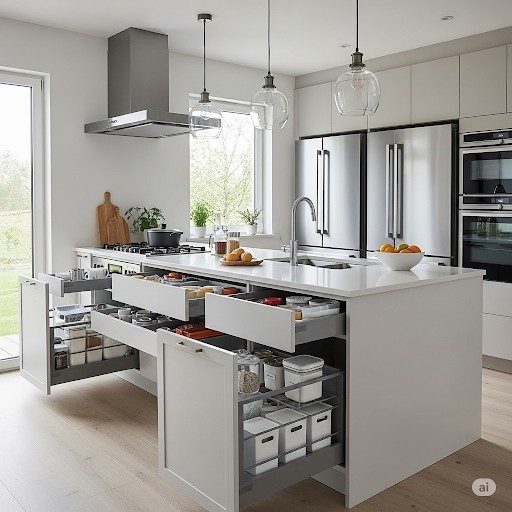
Essential Steps for Organizing Your Kitchen Post-Remodel
Organizing your kitchen post-remodel requires a strategic approach to maximize both functionality and the investment you’ve made in your new space. After months of planning, construction dust, and eating takeout, you’re finally ready to enjoy your beautiful new kitchen. However, the excitement of completion can quickly turn to overwhelm when faced with the task of setting up your space efficiently.
The challenge isn’t just about putting things back where they were before. Your newly remodeled kitchen likely features different storage solutions, updated layouts, and modern conveniences that require fresh thinking about how you organize and use the space. This transformation presents a unique opportunity to reimagine your kitchen workflow and create systems that truly work for your lifestyle.
Assess Your New Kitchen Space and Organizing Your Kitchen Post-Remodel Needs
Before diving into the physical task of organizing your kitchen post-remodel, take time to thoroughly evaluate your new space and its possibilities. This initial assessment phase will save you countless hours of reorganizing later and help you make informed decisions about placement and storage solutions.
Conducting a Complete Inventory Assessment
Start by gathering all your kitchen items in one central location, such as your dining room table or living room floor. Evaluate each item against your new storage capacity and lifestyle needs. This process of organizing your kitchen post-remodel is the perfect time to declutter and donate items that no longer serve your cooking habits.
Group similar items together during this assessment. Create piles for cooking utensils, bakeware, small appliances, dishes, and pantry items. This visual organization will help you understand the volume of each category and plan appropriate storage zones for your kitchen remodeling project.
Analyzing Your Kitchen Workflow Patterns
Understanding your daily kitchen usage patterns is crucial when organizing your kitchen post-remodel because it informs placement decisions that will impact your daily experience. Observe your family’s cooking habits and note which items you reach for most frequently to guide your organization strategy.
Strategic Layout Planning for Maximum Functionality
With a clear understanding of your space and needs, it’s time to plan the strategic placement of items throughout your kitchen. Effective layout planning is the foundation of successful kitchen organization and will determine how smoothly your space functions for years to come.
Creating Efficient Kitchen Zones
The concept of kitchen zones revolutionizes how you think about organizing your kitchen post-remodel. Instead of randomly placing items in available spaces, zones group related items and activities together for maximum efficiency.
Establish a coffee and beverage zone near your coffee maker, complete with mugs, filters, and sweeteners. Create a baking zone that houses measuring cups, mixing bowls, and baking sheets. Design a cooking zone around your stove with pots, pans, and frequently used spices within arm’s reach. Your cleaning zone should center around the sink and dishwasher with cleaning supplies easily accessible.
Organizing Daily Essentials for Easy Access
When organizing your kitchen post-remodel, prioritize accessibility for items you use daily. These essentials should occupy eye-level cabinets and top drawers. Consider exploring kitchen remodel layouts that improve workflow to optimize your space further.
Maximizing Your New Storage Features
Modern kitchen remodeling projects often include innovative storage solutions designed to maximize space and improve accessibility. Learning to use these features effectively is essential when organizing your kitchen post-remodel.
Optimizing Pull-Out Drawers and Organizers
Pull-out drawers transform deep cabinets from dark, hard-to-reach caves into easily accessible storage goldmines. To maximize their potential, use drawer dividers and organizers that prevent items from shifting when the drawer moves.
Store heavier items like pots and pans in lower pull-out drawers, while reserving upper pullouts for lighter items like dishes or glassware. When organizing your kitchen post-remodel, consider the weight capacity of each drawer system and distribute items accordingly.
Making the Most of Corner Solutions
Corner cabinets often pose storage challenges, but modern solutions like lazy Susans and magic corners make these spaces highly functional. When organizing your kitchen post-remodel, reserve these rotating systems for items you access regularly but don’t need at arm’s reach.
Lazy Susans work excellently for spices, condiments, oils, and vinegars. Group similar items together on each level and avoid overloading any section, which can make the system difficult to rotate smoothly.
Streamlining Your Pantry Organization System
Whether your remodel included a dedicated pantry or improved cabinet and countertop storage, creating an organized food storage system is crucial for kitchen efficiency and reducing food waste.
Categorizing Food Items by Type and Frequency
When organizing your kitchen post-remodel, group pantry items logically to make meal planning and cooking more efficient. Create zones for breakfast items, snacks, baking supplies, canned goods, and dry goods like pasta and rice.
Within each category, arrange items by frequency of use. Place everyday items at eye level and reserve higher or lower shelves for occasional-use products. This system makes grocery shopping easier because you can quickly assess what you have and what you need.
Implementing Container Systems and Clear Labels
Transferring dry goods to clear, airtight containers serves multiple purposes when organizing your kitchen post-remodel. These containers protect food from pests, maintain freshness longer than original packaging, and create a visually appealing, organized appearance.
Choose containers with tight-fitting lids and consider stackable options to maximize vertical space. Label each container clearly with both the contents and expiration date to maintain food safety and organization over time.
Design Tips for Maintaining a Clutter-Free Kitchen
A successful kitchen organization system isn’t just about the initial setup — it’s about creating sustainable habits that maintain the beauty and functionality of your remodeled space. If you’re considering a complete renovation, learn more about how to create a timeless kitchen remodel look for lasting appeal.
Maintaining Clear Countertops Daily
Clear countertops are the hallmark of an organized kitchen and essential for maintaining the aesthetic appeal of your remodel. When organizing your kitchen post-remodel, establish designated homes for every item that typically ends up on counters.
Create a “landing zone” near your kitchen entrance for items like keys, mail, and shopping bags. Store frequently used appliances in easily accessible cabinets rather than leaving them on counters permanently.
Smart Appliance Storage Solutions
Small appliances can quickly overwhelm kitchen counters and cabinets. When organizing your kitchen post-remodel, be strategic about which appliances earn counter space and which should be stored.
Daily-use appliances like coffee makers and toasters can remain on counters, but occasional-use items like stand mixers and food processors should have dedicated storage spaces. Consider appliance garages or pull-out shelves that make accessing stored appliances easy while keeping them out of sight.
When planning your storage solutions, consider reading about kitchen remodel layouts that improve workflow to optimize your space further.
Creating Your Dream Kitchen: Final Thoughts
Successfully organizing your kitchen post-remodel transforms your beautiful new space into a highly functional culinary haven. By implementing strategic zones, maximizing innovative storage features, and maintaining consistent daily habits, you’ll create an efficient workflow that enhances your cooking experience.
Remember, organizing your kitchen post-remodel is an investment in your daily quality of life. The time spent thoughtfully arranging your space will pay dividends in reduced stress, improved efficiency, and greater enjoyment of your newly remodeled kitchen for years to come.
At Mazzamuto Construction, we’re here to help you achieve your dream kitchen from design to organization.
Ready to Transform Your Home?
At Mazzamuto Construction, we believe great spaces start with thoughtful planning and skilled craftsmanship. Whether you’re exploring ideas or ready to build, our team is here to guide you every step of the way. Let’s bring your vision home—contact us for a personalized consultation today!
Frequently Asked Questions
1. How to organize your kitchen after moving?
Focus on unpacking essentials first, then gradually organize based on your cooking patterns and the new space layout.
2. What is a realistic budget for a kitchen remodel?
Kitchen remodels typically range from $15,000-$50,000, depending on scope, materials, and local labor costs. For more detailed planning information, check out our guide on kitchen remodel timelines.
3. How do I decide where to put things in my kitchen?
Place items based on frequency of use and proximity to related tasks — keep cooking utensils near the stove, dishes near the dishwasher.
4. How long does it take to fully organize a kitchen after remodeling?
Most homeowners need 2-4 weeks to fully settle into their new kitchen organization system.
5. What are the most important storage features to prioritize when organizing your kitchen post-remodel?
Focus on pull-out drawers for easy access to deep cabinets, corner solutions like lazy Susans for hard-to-reach spaces, and vertical storage options such as door-mounted organizers. These features maximize functionality and help maintain long-term organization.
For those planning future projects, you might also be interested in exploring whole home remodeling options or learning about home additions to expand your living space.
Key Takeaways
- Start with a thorough assessment of your new space and existing items before placing anything in cabinets to prevent future reorganization
- Create functional zones based on your actual cooking workflow rather than arbitrary placement to minimize steps during food preparation
- Utilize all new storage features to their maximum potential by understanding their intended purpose and capacity for improved efficiency
- Maintain organization through consistent daily habits like clearing countertops and returning items to their designated homes immediately after use




